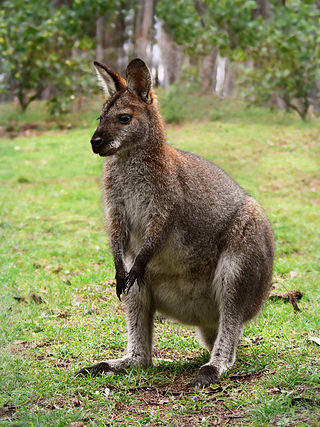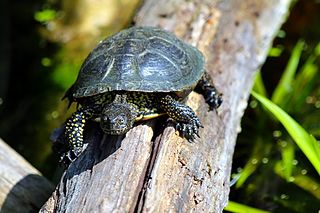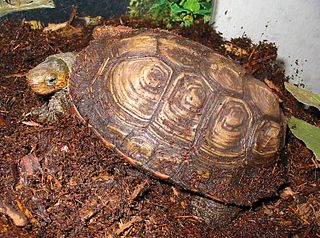
Equidae is the taxonomic family of horses and related animals, including the extant horses, asses, and zebras, and many other species known only from fossils. The family evolved around 50 million years ago from a small, multi-toed ungulate into larger, single-toed animals. All extant species are in the genus Equus, which originated in North America. Equidae belongs to the order Perissodactyla, which includes the extant tapirs and rhinoceros, and several extinct families.
Genus is a taxonomic rank used in the biological classification of living and fossil organisms as well as viruses. In the hierarchy of biological classification, genus comes above species and below family. In binomial nomenclature, the genus name forms the first part of the binomial species name for each species within the genus.

Moles are small mammals adapted to a subterranean lifestyle. They have cylindrical bodies, velvety fur, very small, inconspicuous eyes and ears, reduced hindlimbs, and short, powerful forelimbs with large paws adapted for digging.

Columbidae is a bird family consisting of doves and pigeons. It is the only family in the order Columbiformes. These are stout-bodied birds with short necks and short slender bills that in some species feature fleshy ceres. They primarily feed on seeds, fruits, and plants. The family occurs worldwide, but the greatest variety is in the Indomalayan and Australasian realms. The family contains 344 species divided into 50 genera. Thirteen of the species are extinct.

A wallaby is a small or middle-sized macropod native to Australia and New Guinea, with introduced populations in New Zealand, Hawaii, the United Kingdom and other countries. They belong to the same taxonomic family as kangaroos and sometimes the same genus, but kangaroos are specifically categorised into the four largest species of the family. The term "wallaby" is an informal designation generally used for any macropod that is smaller than a kangaroo or a wallaroo that has not been designated otherwise.

Ovenbirds or furnariids are a large family of small suboscine passerine birds found from Mexico and Central to southern South America. They form the family Furnariidae. This is a large family containing around 315 species and 70 genera. The ovenbird, which breeds in North America, is not a furnariid – rather it is a distantly related bird of the wood warbler family, Parulidae.

Emydidae is a family of testudines (turtles) that includes close to 50 species in 10 genera. Members of this family are commonly called terrapins, pond turtles, or marsh turtles. Several species of Asian box turtles were formerly classified in the family; however, revised taxonomy has separated them to a different family (Geoemydidae). As currently defined, the Emydidae are entirely a Western Hemisphere family, with the exception of two species of pond turtle.

Old World monkey is the common English name for a family of primates known taxonomically as the Cercopithecidae. Twenty-four genera and 138 species are recognized, making it the largest primate family. Old World monkey genera include baboons, red colobus and macaques. Common names for other Old World monkeys include the talapoin, guenon, colobus, douc, vervet, gelada, mangabey, langur, mandrill, surili (Presbytis), patas, and proboscis monkey. Phylogenetically, they are more closely related to apes than to New World monkeys. They diverged from a common ancestor of New World monkeys around 45 to 55 million years ago.

Neurotrichus is a genus of shrew-like moles. It is classified, together with the fossil genus Quyania, in the tribe Neurotrichini of the subfamily Talpinae. The only living species is the American shrew-mole (N. gibbsii) of the northwestern United States and British Columbia. A fossil species, Neurotrichus columbianus from the Hemphillian of Oregon, was placed in the genus in 1968, but this animal is now thought to be more closely related to the Chinese fossil genus Yanshuella.

Emys is a small genus within the family Emydidae. The genus, consisting primarily of freshwater pond turtles, is endemic to Europe. It is the only genus in the Emydidae outside of North America.

The genus Cathartes includes medium-sized to large carrion-feeding birds in the New World vulture (Cathartidae) family. The three extant species currently classified in this genus occur widely in the Americas. There is one extinct species known from the Quaternary of Cuba.

Rhinoclemmys is a genus of turtles in the family Geoemydidae, the only genus in the subfamily Rhinoclemmydinae. Member species of the genus are commonly known as the Neotropical wood turtles and are the only geoemydids known from the Americas. As such, they have adapted to a wide range of habitats, which is reflected in the species' common names.

Jean Paul Vuillemin was a French mycologist born in Docelles.

Hubert Bourdot was a French Roman Catholic priest and mycologist who was a native of Imphy, a community in the department of Nièvre.

The Corticiales are an order of fungi in the class Agaricomycetes. The order is composed of corticioid fungi. Species within the order are generally saprotrophic, most of them wood-rotters, but several are parasitic on grasses or lichens. Plant pathogens of economic importance include Erythricium salmonicolor, Laetisaria fuciformis, Waitea circinata, Waitea oryzae, and Waitea zeae.

Vuilleminia is a genus of corticioid fungi in the family Vuilleminiaceae. It is named after the French mycologist Paul Vuillemin. According to a 2008 estimate, the genus contains 10 species which collectively have a widespread distribution.
The Vuilleminiaceae are a family of fungi in the order Corticiales. The family in its current sense is based on molecular research and contains just three genera of temperate corticioid fungi.

Grammoptera abdominalis is a species of beetle in family Cerambycidae. It is found in the Palearctic The species is widespread in Europe eastward to the Caucasus. In the Nordic region, the species is very rare. The larvae develop in dead branches of oak attacked by fungi, especially the species Vuilleminia comedens, but it is possible that it is not specifically related to this species. Larvae development probably takes two years. The adults can be found in May–June, preferably on flowers.

Grammoptera ustulata is a species of beetle in family Cerambycidae. It is found in the Palearctic

Carnivoraformes is a clade of placental mammals that includes the modern order Carnivora and its extinct stem-relatives.


















